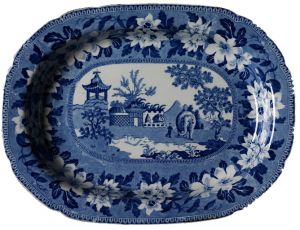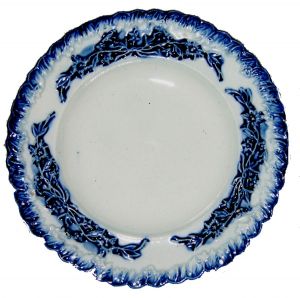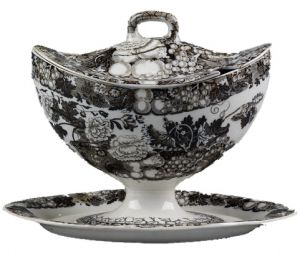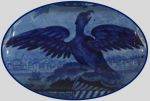John Rogers & Son
|
The brothers John and George Rogers are listed in Bailey’s Directory of 1784 as manufacturers of china glazed blue painted wares and cream coloured at Burslem. It is likely that at this date they were operating from the potworks which their father Francis had owned and which he left to John, the elder son, in his will. By 1789 the brothers were potting in Longport and in 1796 George insured a second and newly built potworks in his own name, although documentary evidence indicates that the brothers continued to trade as partners. George Rogers died in April 1815 and John in December 1816. John had a son, Spencer Rogers, who inherited the business and continued to trade as ‘John Rogers & Son’. Spencer Rogers continued in business until 1842, in which year he was adjudicated bankrupt.[1] Evidence of the firm’s American trade is to be found in the order book of the Boston merchant Horace Collamore, who gave the factory three orders; the first, for twenty five crates on 23rd May, 1814; the second, for three crates and five hogsheads on 4th December 1815; and the third, for twenty five crates, on 4th May 1816. The last order was placed to ‘John Rogers & Son’, noting the change of title following the death of one of the founding partners. The first order included ten crates of printed tea and table ware. The named patterns were Stag, Zebra, Camel, Elephant and Oriental. In the second, the printed part comprised dining ware and muffins (i.e. plates) in Roman Statue and Willow and teas in ‘old Camel and Rose Border’. The printed element of the third order included plates of various sizes in Willow, Roman Statue, Stag, Zebra and Hindustan and teawares in Marine, India and ‘Marine and Rose Border’. None of these patterns can be identified with the known American views made by the Rogers firm, although it is conceivable, but still to be proved, that ‘Marine’ may have been the contemporary name for the pattern now known by collectors as ‘Boston Harbour’. The bulk of Rogers’ blue printed output was medium rather than dark in colour. Collamore’s Order Book contains two entries which suggest that the American demand for a darker blue tone developed around 1817-1818: on 19th September 1817, he ordered from Mayer & Keeling of Shelton (a merchant, not a manufacturer) a crate of teapots described as ‘darker blue & brown’; on 13th May 1818, he ordered from John Yates, a Shelton manufacturer, four crates of dark blue printed teaware and tableware. More significantly in the context of Rogers’ output, Mayer & Keeling were given a further order on 19th August 1818 which included ‘blue printed dining ware, new dark pattern, State House’.[2] [1] A detailed history of the Rogers factory is to be found in ‘John and George Rogers of Burslem and Longport’ by Trevor Markin: Northern Ceramic Society Journal Vol. 24 2007-8 at p.37. [2] The Collamore Order & Letter Book is available on microfilm at Old Sturbridge Village, Mass., U.S.A |
 Blue printed dish impressed ROGERS©Victoria and Albert Museum Blue printed dish impressed ROGERS©Victoria and Albert Museum Pearlware plate,impressed ROGERS Pearlware plate,impressed ROGERSWinterthur Museum  Sauce tureen with black print Sauce tureen with black printimpressed ROGERS ©Victoria and Albert Museum |

 The blue
printed wares featuring American views which can be positively attributed to
the Rogers factory by marked pieces are to date limited to Boston Harbour (so
called, although the predominant feature of the design is the American Eagle) and
Boston State House, the latter view being known with some variations in design. No evidence exists to support the attribution
to Rogers of the ‘Shipping Series’ views of sailing vessels with a border of
foliage and mottled sea shells, one of which is said to describe the engagement
of the ‘Shannon’ and the ‘Chesapeake’ on June 1st 1813.
The blue
printed wares featuring American views which can be positively attributed to
the Rogers factory by marked pieces are to date limited to Boston Harbour (so
called, although the predominant feature of the design is the American Eagle) and
Boston State House, the latter view being known with some variations in design. No evidence exists to support the attribution
to Rogers of the ‘Shipping Series’ views of sailing vessels with a border of
foliage and mottled sea shells, one of which is said to describe the engagement
of the ‘Shannon’ and the ‘Chesapeake’ on June 1st 1813.